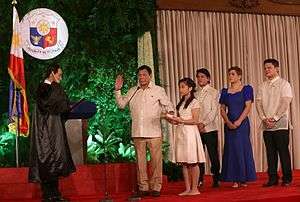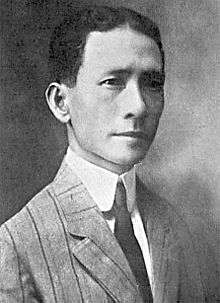Philippine presidential line of succession
 |
|---|
| This article is part of a series on the politics and government of the Philippines |
|
Constitutional commissions |
The Philippine presidential line of succession defines who becomes or acts as President of the Philippines upon the incapacity, death, resignation, or removal from office (by impeachment and subsequent disqualification) of a sitting president or a president-elect.
Current Order
The current line of succession to the office of President of the Philippines is specified by the 1987 Constitution. During the Marcos era, the line of succession would be amended to include newly created cabinet or ministerial offices. The line of presidential succession follows the order of Vice President, President of the Senate and the Speaker of the House of Representatives. In case of death, permanent disability, or inability of these officials, Congress shall, by law, provide for the manner of selection of the person who is to act as President until a President or Vice President shall have qualified and the line of succession will change of who those new national officials.

Current line of succession
| Key | PDP-Laban | |
|---|---|---|
| NPC | ||
| Liberal |
At the start of the term
- If a President was elected but failed to qualify - the Vice President who was elected will act as President until the President qualifies.
- If there was no President elected - the Vice-President who was elected will act as President until a President is elected and qualifies.
- If at the beginning of the term of the President, the President-elect dies or has become permanently disabled - the Vice President who was elected becomes President.
- If neither President and Vice-President had been chosen or had qualified, or if both had died or had become permanently disabled - the Senate President or, in case of his inability, the Speaker of the House, will act as President until a President or a Vice-President is chosen and qualifies[1]
During the term

- If the President dies, becomes permanently disabled, is removed from office, or resigns - the Vice-President becomes the President and serves the unexpired term.
- If both the President and the Vice President die, become permanently disabled, are removed from office, or resign - the President of the Senate or, in case of his inability, the Speaker of the House of Representatives, will act as President until a President or Vice-President is elected and qualifies.
- If the Acting President dies, becomes permanently disabled, is removed from office, or resigns, Congress shall, by law, provide who shall serve as President. He shall serve until the President or the Vice-President shall have been elected and qualified, and be subject to the same restrictions of powers and disqualifications as the Acting President.[1]
The line of succession in practice
- On August 1, 1944, following the death of President Manuel L. Quezon due to tuberculosis, Vice President Sergio Osmeña took his oath of office and became the second President of the Commonwealth of the Philippines, then a government-in-exile in the United States. As the war in the Pacific Theatre continued, he returned to the Philippines two months later with General Douglas MacArthur and began the campaign to liberate the country. After the war, he restored the Commonwealth government and the various executive departments. Osmeña, who assumed the presidency at age 65, lost to Manuel Roxas in his bid for a full four-year term in his own right in the 1946 presidential election.
- On April 17, 1948, Vice President Elpidio Quirino assumed the presidency, taking his oath of office two days after the death of Manuel Roxas. His first official act as the President was the proclamation of a state of mourning throughout the country for Roxas' death. Since Quirino was a widower, his surviving daughter Victoria Quirino served as the official hostess and performed the functions traditionally ascribed to the First Lady. Quirino won the 1949 presidential election and secured a four-year term in his own right.
- On March 17, 1957, Vice President Carlos P. Garcia was heading the Philippine delegation to the SEATO conference, then being held at Canberra, Australia.[2] Vice President Garcia hastily traveled back to Manila when he was informed of the death of President Ramon Magsaysay in a plane crash in Cebu. Upon his arrival, he immediately returned to Malacañang Palace to assume the duties of President. Supreme Court Chief Justice Ricardo Paras was at hand to administer the oath of office and Garcia became the 8th President of the Philippines. President Garcia's first actions dealt with the declaration of a period of mourning for the whole nation and the burial of his late predecessor.[2] Garcia was elected to a full four-year term in the 1957 presidential election, which was held a few months after Magsaysay's death.
- On January 20, 2001, Vice President Gloria Macapagal-Arroyo took her oath of office as the 14th President of the Philippines before Chief Justice Hilario Davide, Jr. following the ouster of President Joseph Ejercito-Estrada. She had earlier resigned her cabinet position as Secretary of Social Welfare and Development and joined the growing opposition to the president, who faced impeachment. Estrada was forced from office by the EDSA Revolution of 2001. She was elected to a full six-year term in the 2004 presidential election and was sworn in on June 30, 2004. Following her presidency, she was elected to the House of Representatives, making her the second Philippine president after Jose P. Laurel to pursue a lower office after their presidency.
References
- 1 2 www.Batasan.org 1987 Constitution of the Philippines (accessed November 19, 2007).
- 1 2 Molina, Antonio. The Philippines: Through the centuries. Manila: University of Sto. Tomas Cooperative, 1961. Print.